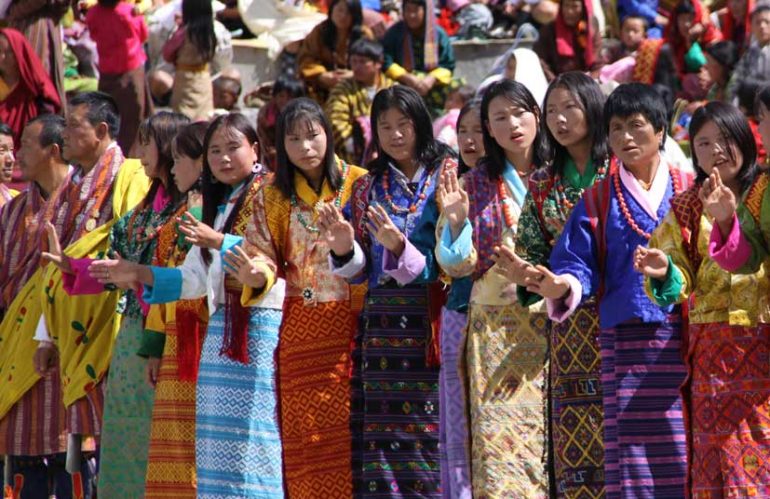| Land Area | 38,394 sq. km |
| Forest Cover | 70.5 % |
| Population 2012 (Projected) | 720,679.00 |
| Population Growth Rate | 1.3% |
| Density of population | 18.91 people per sq. km |
| Capital | Thimphu |
| Main cities (map attached) | Thimphu (The capital)
Punakha (The old capital) Samdrup Jongkhar (One of the most important trading town for eastern districts of Bhutan) Trongsa (Bhutan’s most impressive fortress. The seat of power of the Wangchuck dynasty before it became rulers of Bhutan in 1907) Mongar (The fastest-developing dzongkhag (district) in eastern Bhutan) Phuntsholing (Bordering India and center of trade and commerce) Bumthang (Important religious center) Paro (Location of Bhutan’s only international airport) |
| Climate
Temperature |
Himalayan regions: 0°C (December to February) to 10°C (June to August)
Inner central valleys: -5°C (December to February) to 30°C (June to August) Southern foothills and border area: 15°C (December to February) to 30°C (June to August) |
| Rainfall | Himalayan regions: Less than 500mm per year.
Inner central valleys: 500mm to 1000mm per year. Southern foothills: 2000mm to 3500mm per year. Southern border area: 3000mm to 5000mm per year |
| National Language | Dzongkha is the national language. However, English is used for daily official and business communication |
| National Currency | Ngultrum (Nu.), subunit Cheltrum (Ch) |
| National Day | 17th December |
| National Symbol | The national emblem is contained in a circle and is composed of a double diamond-thunderbolt or Vajra placed just above a lotus, surmounted by a jewel and framed by two dragons. The thunderbolt symbolizes the harmony existing between secular and religious power. The lotus represents purity; while the jewel stands for sovereign power; and the two dragons, male and female depict the name of the country, the land of thunder and dragons. |
| Calendar | The Bhutanese calendar is a variant form of the main Tibetan calendars. It is very much like the Phugpa system, but has different values for some of the main variables. The weekdays are one ahead, not only of the main Tibetan calendars, but the western calendar as well. However, western calendar is used for daily business activities. |
| Working days | Private Sector:
Monday to Saturday 9:00 am to 5:00 pm Banks: Monday to Friday 9:00 am to 5:00 pm Saturday 9:00 am to 1:00 pm
Shops/Stores: Monday to Sunday (Closed on Tuesday) 8:00 am to 8:00 pm
Public Sector: Monday to Friday 9:00 am to 5:00 pm (until 4:00 pm in winter) |
| Official holidays | 16 public holidays
Losar (Bhutanese New Year): celebrated between February and March according to the Bhutanese calendar Tsechu Festival: Up to 5 days each at different districts and timings October 6 – 8 in Thimphu (Capital) |
| Measurements and weights | Weights: Ton – Kilogram
Measurements: Meter – kilometer – centimeter |
| Time Zone | GMT + 6:00 |
| Internet code | .bt |
| Phone code | ++975 |
| Fixed line telephone subscribers, 2011 | 27,488.00 |
| Cellular mobile subscribers, 2011 | 497,571 |
| Postal Infrastructure, 2011 | 114 Postal outlets |
| Electricity generation, 2011 | 7,066.50 MU |
| Electricity exports, 2011 | 5,283.90 MU |
| Tourist arrivals, 2011 | 37,497 |
| Revenue earned from tourism, 2011 | 47.68 Mn. US $ |
| GDP (Current Price), 2011 | 85,176.40 Mn. Nu. |
| Average Inflation rate (year on year), 2011 | 8.45% |
| Purchasing power of Nu., 2010 (base year = 2003) | 0.61 Nu. |
| Education levels | – High School (Gr. 9 -12)
– Bachelors (4 years) – Masters (2 years) – Other professional degrees like medicine, dentistry and law require a certain number of years after a Bachelor’s degree and may have additional requirements |
| Median age, 2012 | 25.3 years |
| Type of government | Constitutional Monarchy |
